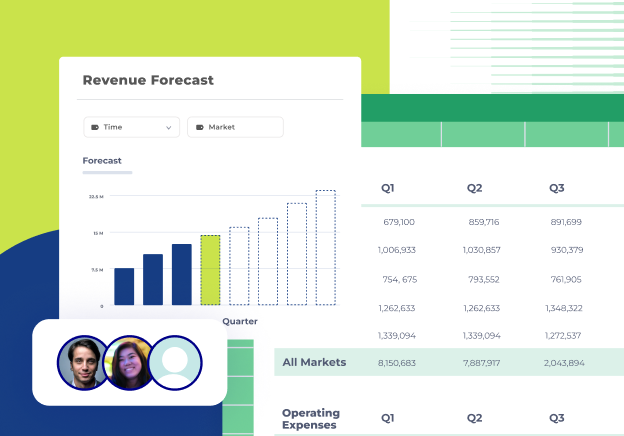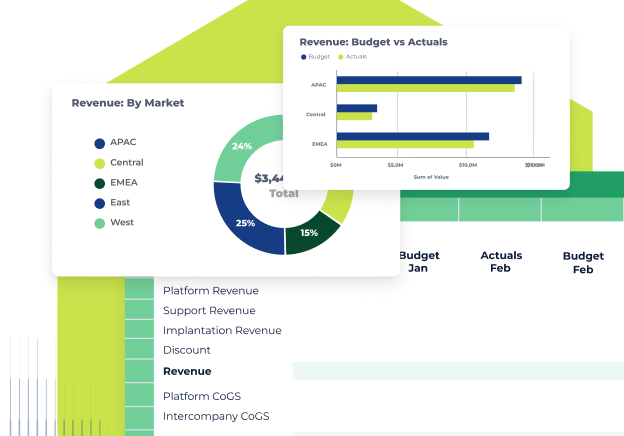Product
Solutions
resources
Company
Congrats on your score!
Your FP&A is Defined.
You're making great strides! Next steps: Tear down silos through deeper cross-functional collaboration and implement xP&A best practices that combine financial and operational data. Keep reading to learn more.
Grow your FP&A prowess
Ready to take things to the next level? To elevate your team, focus on three key areas: First, strengthen partnerships across departments by integrating operational data. Second, adopt advanced planning techniques that incorporate sophisticated analytics and robust data management. Lastly, streamline your performance tracking processes by implementing standardized, automated systems.
Become a trusted partner
Work closely with other departments beyond just reporting. This will help you understand what drives the business better, give more strategic insights, and make finance a key partner in the company.
Foster xP&A best practices
Ditch the siloed number-crunching and manual reporting. Integrate operational and financial data from across the business into a unified view. Then leverage advanced modeling to drive smarter decision-making.
Streamline with standardization
Create clear processes, templates, and use automation to simplify data gathering, forecasting, and reporting. This will save time, cut costs, and improve accuracy.
Where are you on the path to strategic finance mastery?
1
Foundational
Laying groundwork
- Not yet fully aligned with the broader strategic goals of your company
- Work to be done to standardize the planning process outside of the annual budget
- Basic financial model and reporting
- Operating with unstructured data and no formal model or static model
2
Developing
Iterative improvements
- Finance part of decision-informing processes at a broader level
- Annual planning process (not clearly defined) but with occasional reporting to stakeholders
- Non-value-added tasks are automated. Starting to implement basic best practices, along with an annual planning process
- Leveraging a partially driver-based model
3
Defined
Holistic FP&A
- Finance provides critical insights and analysis that drive decision-making
- Defined planning process with regular reporting cadence and communication with stakeholders
- Clearly defined reporting, planning and performance management, and company-wide collaboration
- Fully driver-based model
4
Refined
Optimized XP&A
- Finance is fully connected to the strategy, and drives innovation, helping to shape strategic direction
- The annual planning process is defined where owners can drive updates and changes to/from finance independently with approvals
- Standardized performance management that reduces cost, improves speed, accuracy, and transparency of forecasts and reporting
- Leveraging a fully driver-based model with automation from users and systems
5
Masterful
XP&A mastery
- Finance is a key driver of change and is recognized as a strategic partner at the highest levels of the business
- Predictive / statistical forecasting is combined with performance management and iterative planning, replanning, reporting, analytics, and reforecasting
- Fully driver-based and in real-time
The guiding principles of strategic finance
Foresight
The proactive anticipation of future financial trends and challenges, enable companies to make informed decisions and strategic plans. This principle emphasizes the use of data analytics, scenario planning, and forecasting techniques to predict potential outcomes and mitigate risks.
Alignment
Financial strategies and goals should closely align with your business objectives and operational plans. Strategic leaders foster collaboration across departments, ensuring everyone works towards a common mission.
Storytelling
Storytelling in FP&A transforms complex financial data and analyses into compelling narratives that stakeholders can easily understand and act upon. Effective storytelling bridges the gap between financial experts and non-financial stakeholders, facilitating better decision-making.
Balance
FP&A involves managing the trade-offs between short-term financial performance and long-term strategic goals. Careful evaluation of risks and opportunities is a heavy weight on a finance leader’s shoulders. By striving for balance, organizations can navigate financial complexities while achieving both immediate and future objectives.
Learn from finance professionals just like you
“I think being a human in finance is a sometimes forgotten skill.”
Julia Coto
CFO, Chartspan Medical Technologies
"Human error is going to create mistakes. You can’t audit every line."
Amanda Hoppe
Director of Finance & Adminstration, Freedom Games
“The CFO is much more of a strategic role nowadays, and that extends down into finance and FP&A.”
Allen Michaelis
Senior Director of Finance, Bluewind Medical
“I think being a human in finance is a sometimes forgotten skill.”
Julia Coto
CFO, Chartspan Medical Technologies
"Human error is going to create mistakes. You can’t audit every line."
Amanda Hoppe
Director of Finance & Adminstration, Freedom Games
“The CFO is much more of a strategic role nowadays, and that extends down into finance and FP&A.”
Allen Michaelis
Senior Director of Finance, Bluewind Medical
Bookmark these FP&A
and finance resources
.png)
Strategic planning
xP&A: How to conduct extended planning and analysis
Learn all about extended planning and analysis (xP&A), or the new FP&A: holistic financial planning. Curious about what sets it apart?
Read more
.png)
Professional development
From number-cruncher to strategic leader: the changing face of the CFO
Learn how CFOs are making the transition from number-crunchers to strategic leaders.
Read more
-1.png)
Budgeting & Forecasting, Ebook
The future of strategic finance
Discover how to transition from day-to-day financial tasks to becoming a driver of business strategy.
Read more


.png)









.png)